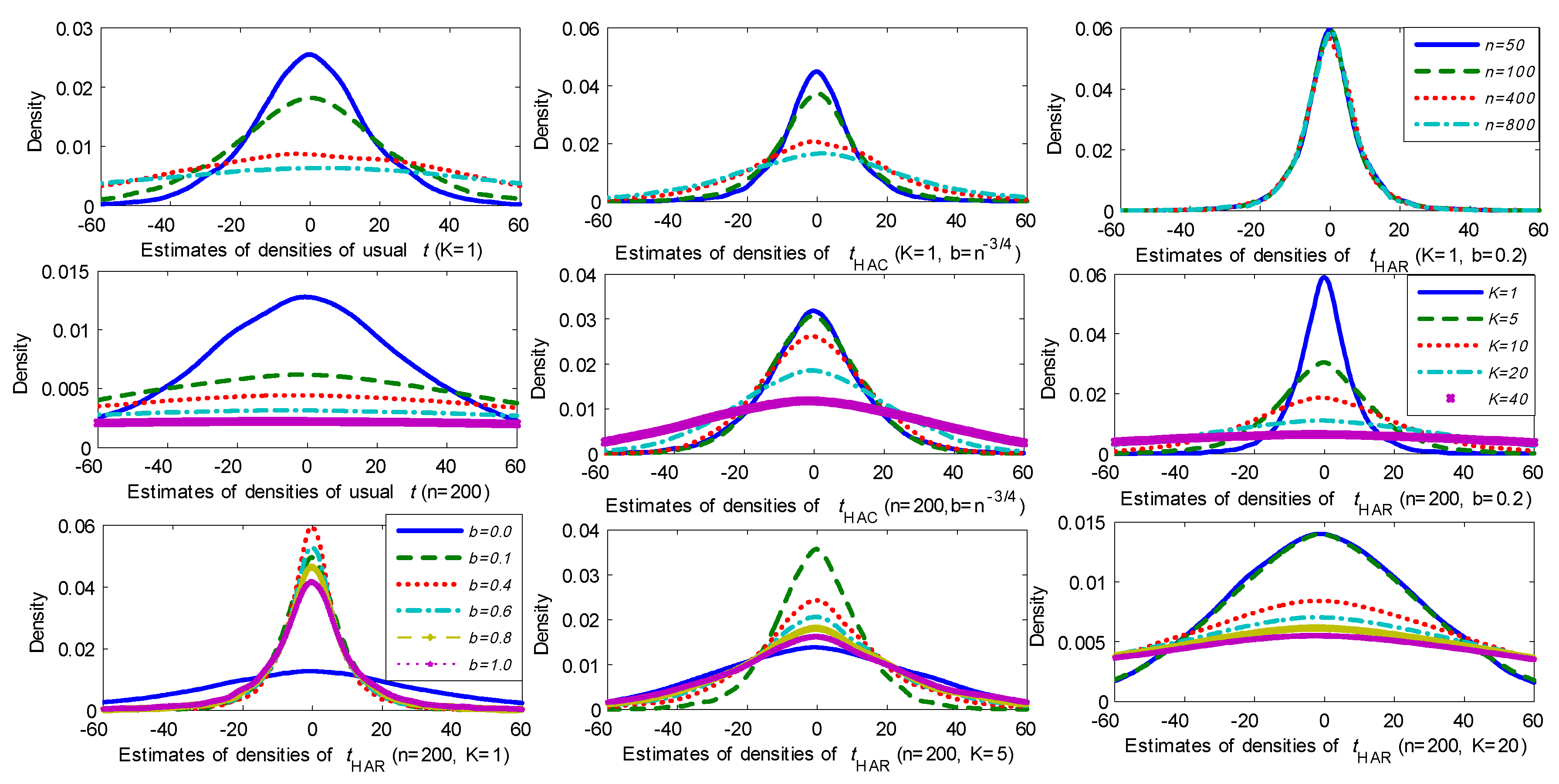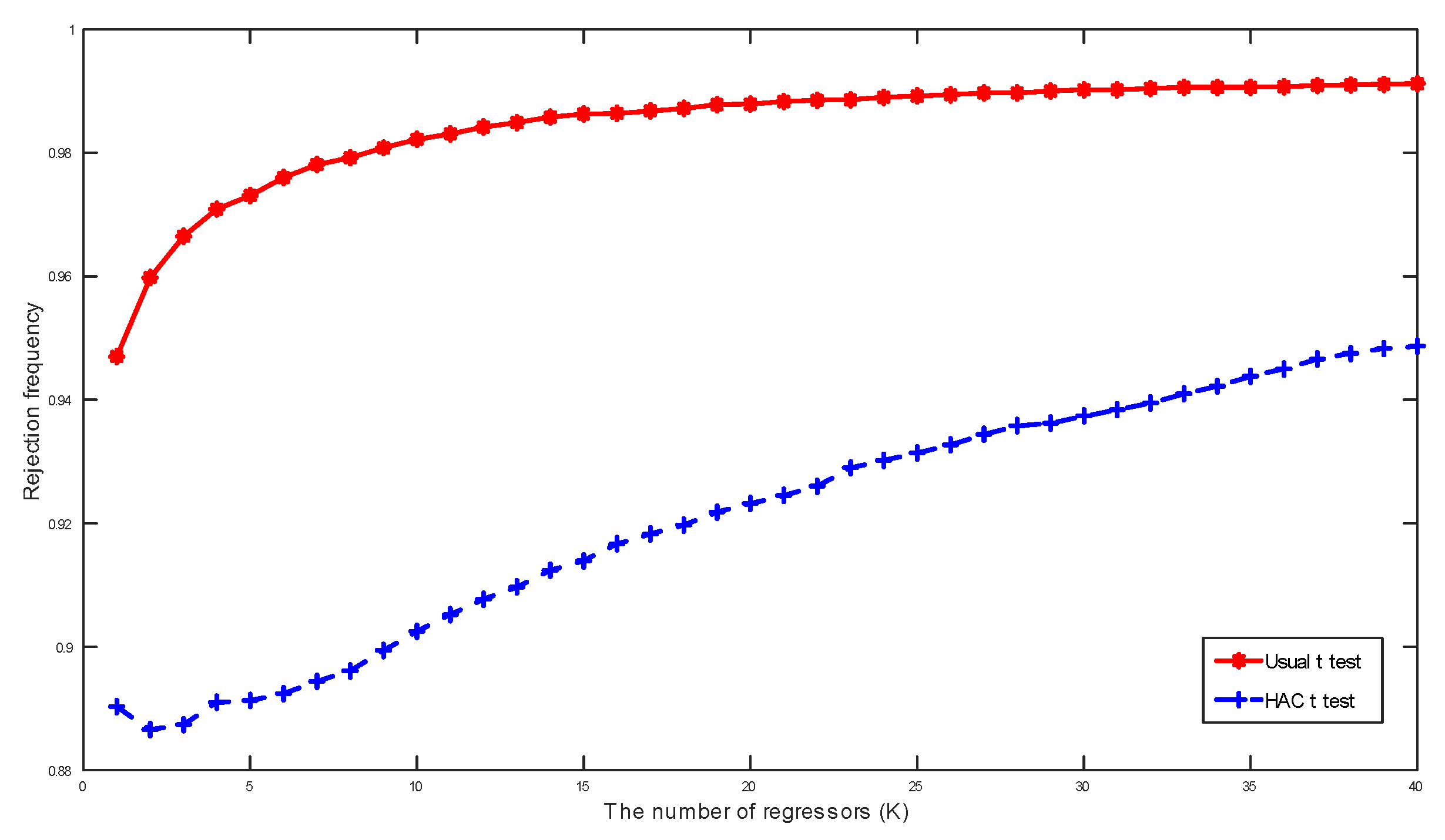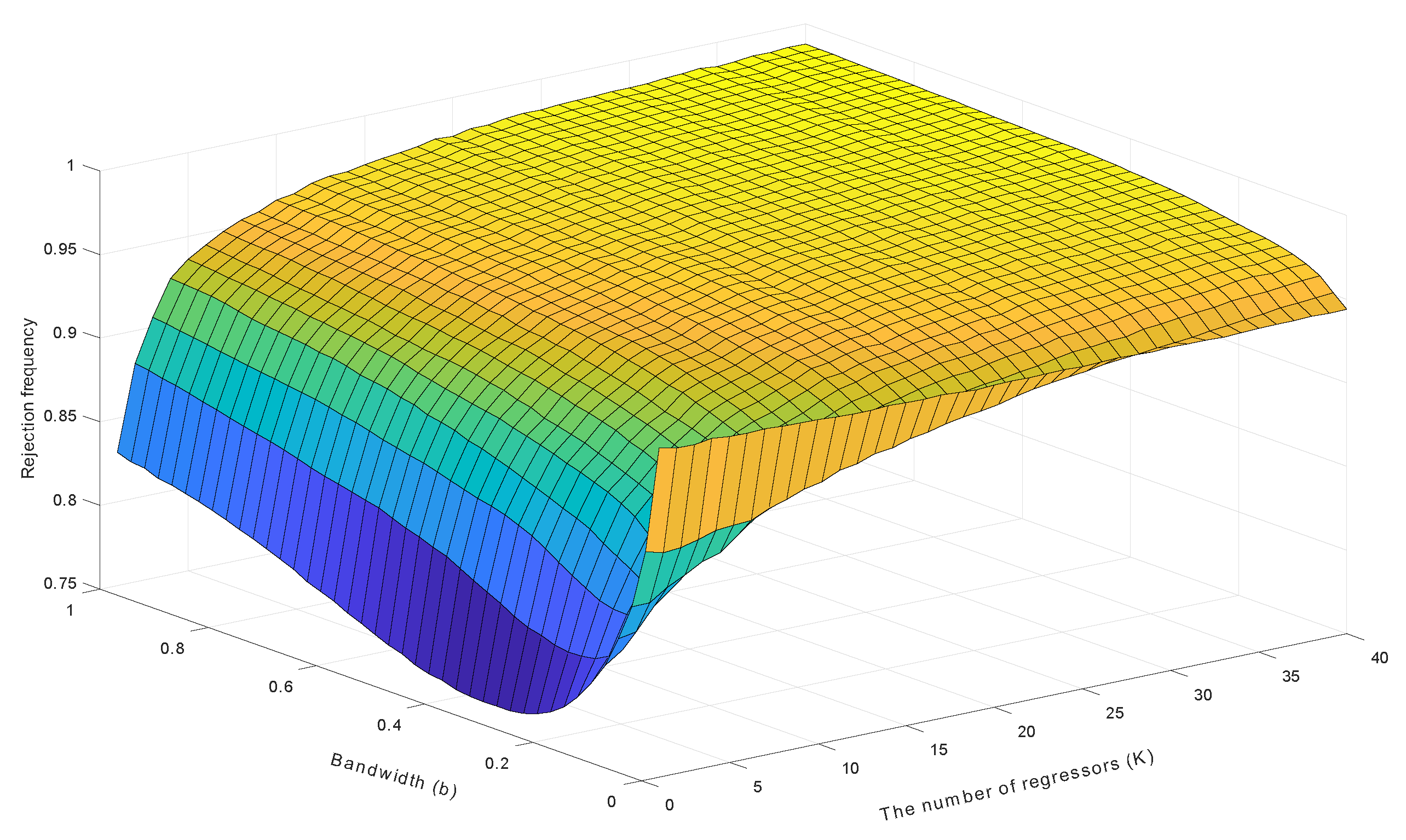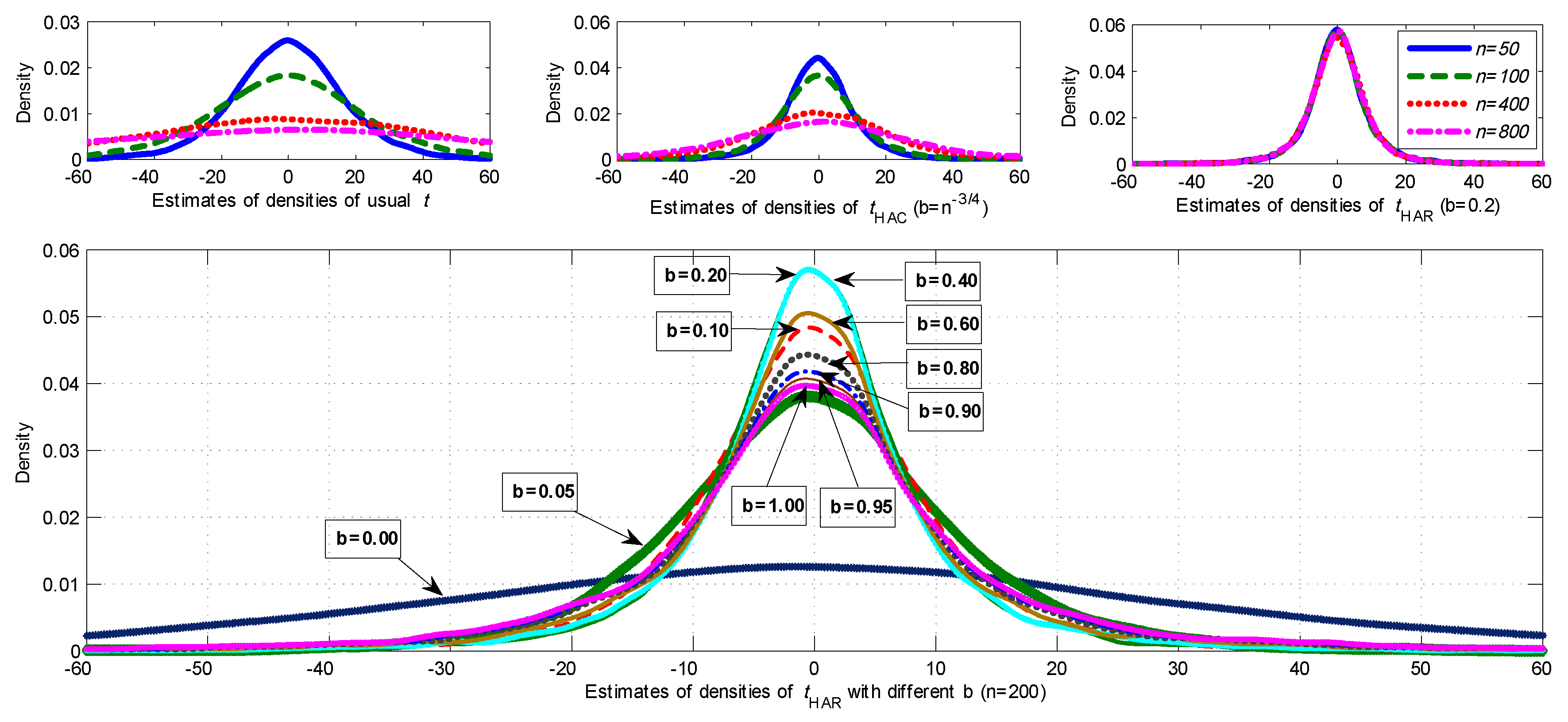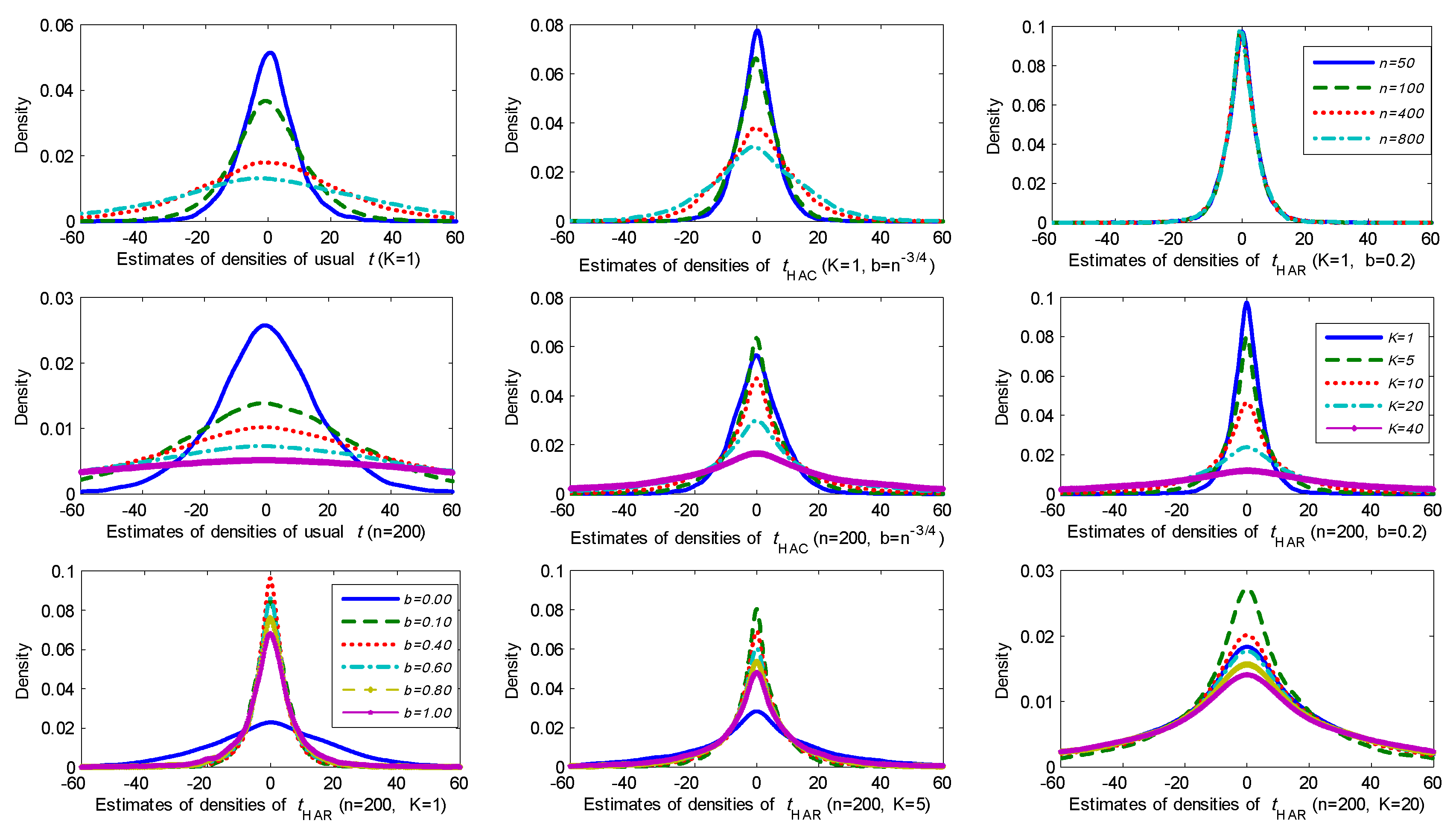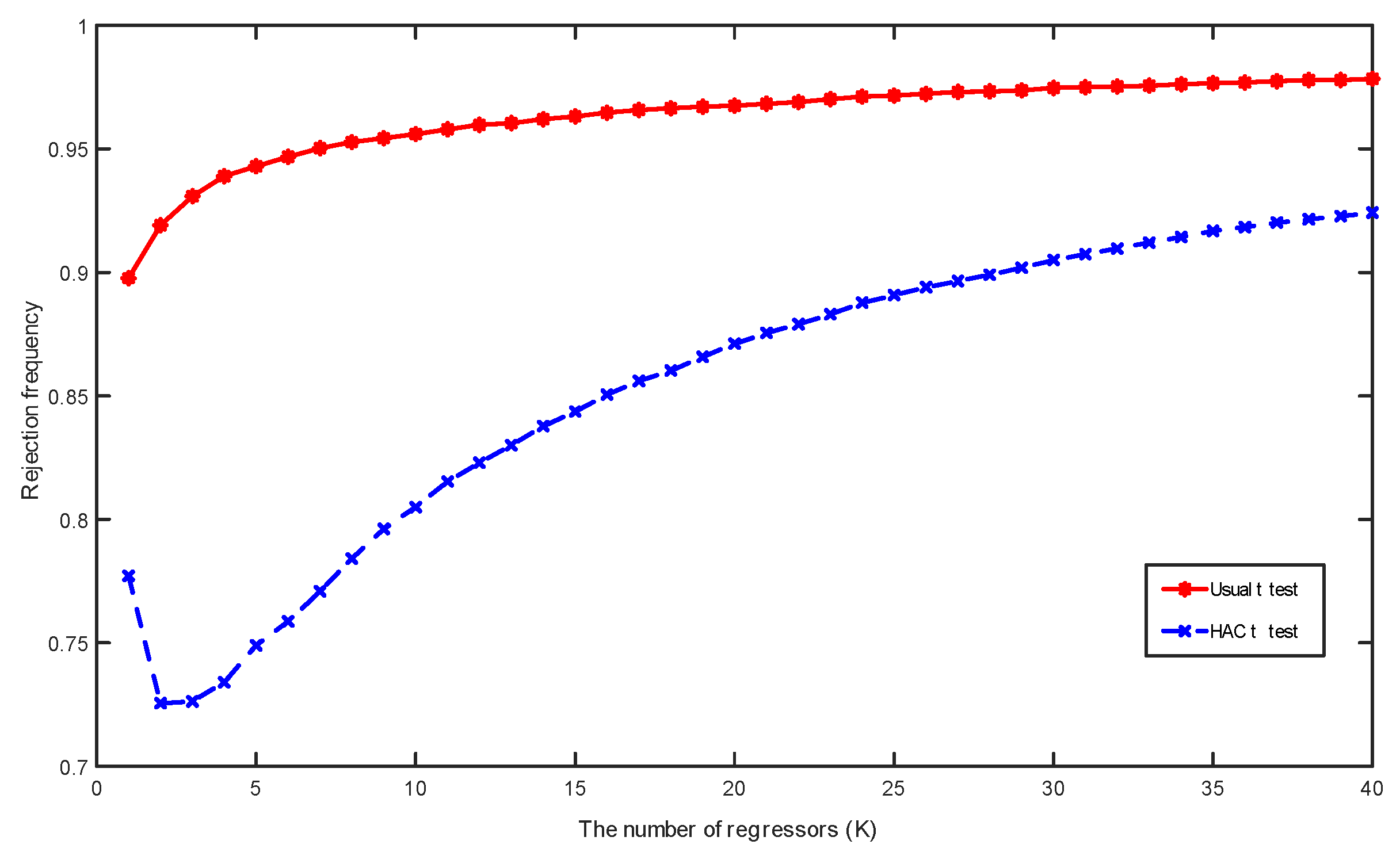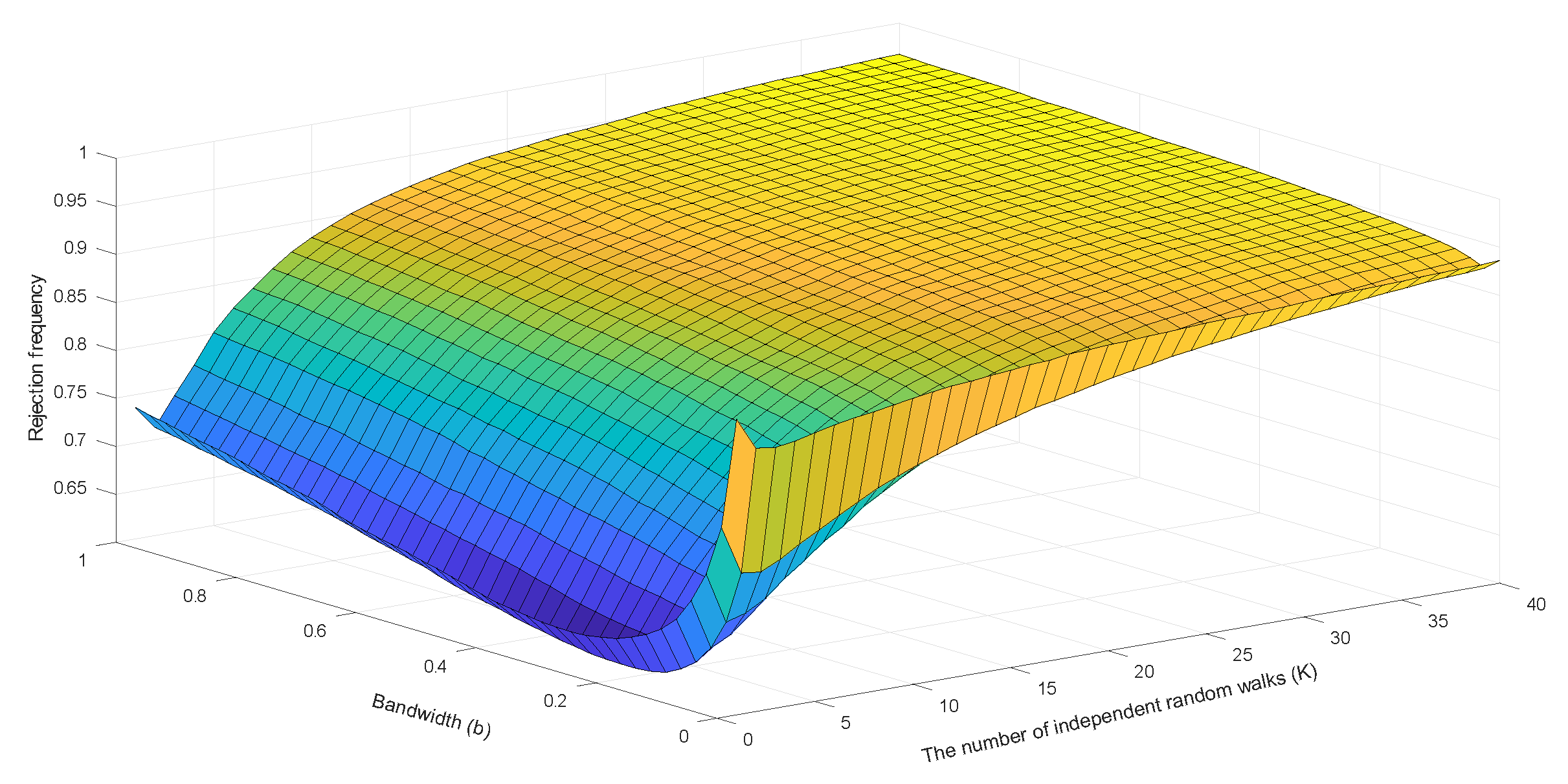1. Introduction
In a well-cited contribution that emphasized the importance of diagnostic testing in econometrics, (
Hendry 1980) highlighted how easy it is to mistake spurious relationships as genuine when using trending data of the type that are so commonly encountered in econometric work, especially in macroeconomics. Spurious regressions occur when conventional significance tests are so seriously biased towards rejection of the null hypothesis of no relationship that the alternative of a genuine relationship is accepted when the variables have no meaningful relationship and may even be statistically independent. Hendry’s article showcased the potential for nonsense regressions with the illustration of a regression between UK consumer prices and cumulative rainfall that displayed a high level of ‘significance’ and passed many—but not all—diagnostic tests.
Spurious regressions continue to attract considerable attention in econometric work, long after the exploratory study by (
Yule 1926), the simulation experiments of (
Granger and Newbold 1974), and the cautionary warnings made by David Hendry and many other writers since then. The limit theory of (
Durlauf and Phillips 1988;
Phillips 1986) provided the first analytic steps forward on this subject by explaining the phenomena of persistent null hypothesis rejections in spurious regressions. These two studies helped applied researchers understand the failure of conventional significance tests by showing that in regressions with independent or even correlated trending I(1) data the usual regression
t- and
F-ratio test statistics do not possess limiting distributions but actually diverge as the sample size
leading inevitably to rejections of the null of no association. Closely related work by (
Phillips and Durlauf 1986;
Durlauf and Phillips 1988;
Park and Phillips 1988,
1989;
Phillips and Hansen 1990;
Phillips and Loretan 1991;
Phillips 1991) extended the analytics to cover models of cointegrated and reduced rank error correction systems. Much of this work was reviewed in a useful form for practitioners by (
Banerjee et al. 1993).
The original study by (
Phillips 1986) on spurious regression asymptotics formed the basis of a large subsequent literature that has analyzed spurious regressions among various classes of trend stationary, long memory, nonstationary, and near-nonstationary time series. A recent article by (
Ernst et al. 2017) provided further analysis by deriving an expression for the standard deviation of the sample correlation coefficient between two independent standard Brownian motions. While this expression does not explain the phenomenon of spurious regression between two independent random walks, it does reveal that the limiting correlation is not centered on the origin and is highly dispersed. This result complements the original findings in (
Phillips 1986) and many subsequent papers that the coefficient of determination in a spurious regression has a well-defined limit distribution and does not converge in probability to zero.
In later work, (
Phillips 1998) pointed out that spurious regressions typically reflect the fact that trending data may always be ‘explained’ by a coordinate system of other trending variables—which includes the example of UK price series being well-explained by cumulative rainfall that was used by David Hendry (
Hendry 1980). In this broad sense of interpretation, there are no spurious regressions for trending time series, just alternative ‘valid’ representations of the time series trajectories (and those of its limiting stochastic process, given a suitable normalization) in terms of other stochastic processes and deterministic functions of time.
The asymptotic theory in (
Phillips 1998) utilized the general representation of a stochastic process in terms of an orthonormal system and provided an extension of the Weierstrass theorem to include the approximation of continuous functions and stochastic processes by Wiener processes. That theory was applied to two classic examples of spurious regressions: regression of stochastic trends on time polynomials, and regressions among independent random walks. Such regressions were shown to reproduce asymptotically in part (and in whole as the regressor space expanded with sample size) the underlying valid representations of one trending process in terms of others, a coordinate system that is entirely analogous to orthonormal or Fourier series representations of a continuous function in terms of polynomials or other simple classes of functions over some interval. An important feature of these ‘valid’ trend relationships is that the coefficients in the representations, like those in the Karhunen–Loève representation of a general stochastic process, are themselves random variables. Randomness in the representation of time-series trajectories is embodied in these coefficients. Much subsequent work has utilized these ideas and analytic methods, either in justifying certain regression representations or in using partial versions of these regression representations to focus on certain features—such as long run features—of the data (notably:
Phillips 2005,
2014;
Müller 2007;
Sun 2004,
2014a,
2014b,
2014c;
Hwang and Sun 2018;
Müller and Watson 2016,
2018).
An important element in the Hendry (
Hendry 1980) discussion of econometric practice was its emphasis on the value of diagnostic testing to ascertain limitations of regressions used in applications. In any empirical regression equation, the properties of the residuals depend inevitably on the properties of the data. To build upon a saying of the famous statistician John Tukey, in the regression equation
the empirical investigator chooses the variables
y and
X (possibly with the aid of an autometric regression or a machine learning algorithm) and god gives back
Any misspecification in the relationship between
y and
X must therefore be manifest in the properties of
This is precisely what occurs in a spurious regression—the residual embodies the consequences of a model’s fundamental error of specification—as is revealed by the fact that tests for residual serial correlation such as the Durbin Watson statistic converge in probability to zero in such regressions (
Phillips 1986).
Accommodating departures in fitted relationships from conventional assumptions on the properties of regression errors and thereby some of the effects of misspecification has been a longstanding goal of econometrics. One of the great advances in econometric research over the last half-century in response to this goal has been the development of methods of inference that are robust to some of the properties of the data and, particularly, those of the regression error. Such robustness can offer protection against specification error in validating inference. This research has led to the progressive development of heteroskedastic and autocorrelation consistent (HAC) procedures
1 and subsequently to heteroskedastic and autocorrelation robust (HAR) methods
2 These methods control for the effects of serial dependence and heterogeneity in regression errors and they play a key role in achieving robustness in inference. One area where methods of achieving valid statistical inference via HAC procedures has proved especially important in practice are regressions that involve trending variables and cointegration. This goal motivated the early research on optimal semiparametric approaches to the estimation of cointegrating relationships (
Phillips and Hansen 1990) and continues to play a role in subsequent developments in this field (
Phillips 2014;
Hwang and Sun 2018).
HAC methods generally have good asymptotic properties but they are susceptible to large size distortions in practical work. Several alternative methods have been proposed in the recent literature to improve finite sample performance. Among these, the ‘fixed-b’ lag truncation rule (
Kiefer and Vogelsang 2002a,
2002b,
2005) has attracted considerable interest. The method uses a truncation lag
M for including sample serial covariances that is proportional to the sample size
n (i.e.,
for some fixed
)) and sacrifices consistent variance matrix (and hence standard error) estimation in the interest of achieving improved performance in statistical testing by mirroring finite sample characteristics of test statistics in the new asymptotic theory of these tests. The formation of
t ratio and Wald statistics based on HAC estimators without truncation belongs to the more general class of HAR test statistics. There are known analytic advantages to the fixed
b approach, primarily related to controlling size distortion. In particular, research by (
Jansson 2004;
Sun et al. 2011;
Sun 2014b) has shown evidence from Edgeworth expansions of enhanced higher-order asymptotic size control in the use of these tests. Recently, (
Lazarus et al. 2018;
Müller 2014;
Sun 2018) have surveyed work in this literature and given recommendations for practical implementation.
In studying spurious regression on trend phenomena, (
Phillips 1996,
1998) showed that the use of HAC methods attenuated the misleading divergence rate (under the null hypothesis of no association) by the extent to which the truncation lag
In particular, the divergence rate of the
t statistic in a spurious regression involving independent
variables is
rather than
. Pursuing this philosophy further, (
Sun 2004) offered a new solution to deal with inference in spurious regressions. He argued that the divergence of the usual
t-statistic arises from the use of a standard error estimator that underestimates the true variation of the ordinary least squares (OLS) estimator. He proposed the use of a fixed-
b HAR standard error estimator with a bandwidth proportional to the sample size (where
M∼
at the same rate as
n). The resulting
t-statistic converges to a non-degenerate limiting distribution which depends on nuisance parameters. These discoveries revealed that prudent use of HAR techniques in regression testing might widen the range of inference to include spurious regression.
In the same spirit as (
Sun 2004,
2014b), the present contribution analyzes possible advantages in using HAR test statistics in the context of simple trend regressions such as
where
is
For trend assessment in models of this type it is of interest to test the null hypothesis
of the absence of a deterministic trend in (
1). This framework is a prototypical example of much more complex models where deterministic trend, stochastic trends, and trend break components may all be present, hence methods of asymptotically valid estimation and testing are needed. A recent general approach to the consistent estimation of such complex models by machine learning filtering methods is given in (
Phillips and Shi 2019).
The present paper considers three types of
t test widely used in econometrics: the usual
t test, the
t test based on HAC covariance matrix estimators, and the fixed-
b HAR test. We apply these
t-statistics to three classic examples of spurious regressions: regression of stochastic trends on time polynomials, regression of stochastic trends on deterministic time trend and regression among independent random walks. The asymptotic behavior of these three different
t-statistics are investigated. In the regression of stochastic trends on time polynomials and the regression among independent random walks, it is shown that the usual
t test and HAC based
t test are likely to indicate a significant relation with probability that goes to one as the sample size
n goes to infinity. However, provided the number of regressors (
K) is fixed, the HAR
t-statistics converge to well-defined distributions free from nuisance parameters. As a result, when appropriate critical values are drawn from these limiting distributions, the HAR
t-statistics would not diverge and valid inference on the regression coefficients would be possible, concordant with (
Sun 2004).
In contrast to these results and those of (
Sun 2004), we find that HAR
t-statistics diverge at rate
as
. Hence, the characteristics of spurious regression return even with the use of HAR test statistics in models with an increasing number of regressors. These findings seem relevant for machine learning and autometric model building methods which accommodate large numbers of regressors, including those of the
variety where model searching often begins with more regressors than sample observations and penalized methods of estimation are needed to obtain even preliminary results.
Our results also reveal that the other two t-statistics (the usual t and HAC-based t) diverge at greater rates when than when K is fixed. In the regression of stochastic trends on deterministic time trends, we derive the limiting distributions of the statistics under both the null and alternative hypotheses. The HAR test turns out to be the only test which is consistent and has controllable size. All the limit theory for these tests receives strong support in simulations. As will become evident, the appealing asymptotic properties of the HAR test in the fixed number of regressors case are manifest even in situations where some commonly-used regularity conditions in the construction of HAR tests are violated.
The rest of the paper is organized as follows.
Section 2 examines regressions of stochastic trends on a complete orthonormal basis in
and establishes the limiting distributions of the three different
t-statistics with explicit application to the prototypical case of a spurious linear trend regression.
Section 3 examines the limit behavior of the
t-statistics in regressions among independent random walks. Simulations are reported in
Section 4.
Section 5 concludes. All proofs are given in the
Appendix A,
Appendix B and
Appendix C.
3. Regressions Among Independent Random Walks
This section extends these ideas to regressions among independent random walks. Let
be a Brownian motion on the interval
. (
Phillips 1998) proved that there exist a sequence of independent standard Brownian motions
that are independent of
, and a sequence of variables
defined on an augmented probability space
such that, as
,
The random coefficients
are statistically dependent on
. Replacing the Wiener processes
by orthogonal functions
in
using the Gram-Schmidt process
gives the representation
In the following, we consider the unit root process
with mean zero stationary components
with continuous spectral density
and satisfying the functional law
Let
be
K independent standard Gaussian random walks, all of which are independent of
. Consider the linear regression
, based on
observations of these series. The large
n asymptotic behavior of
is (
Phillips 1986)
where
is the vector standard Brownian motion weak limit of the standardized partial sum processes
.
Suppose we orthogonalize the regressors
using the Gram-Schmidt process
By standard weak convergence arguments we have
Now let
, and consider the regression
The LS estimator
has the limit
where
is a
vector. Thus, the empirical regression of
on
reproduces the first
K terms in the representation of the limit Brownian motion
B in terms of an orthogonalized coordinate system formed from
K independent standard Brownian motions.
Suppose now that we are interested in testing whether a linear combination of
equals zero, viz.,
with
satisfying
. Again, three types of
t-statistics are considered:
where
is a kernel function,
and
for
.
The following theorem establishes the limiting distributions of these three t-statistics.
Theorem 3. For fixed K, as ,
(ii) When (iii)where and Remark 3. As it is shown in Theorem 3, and diverge at rate and , respectively. Hence, such tests indicate inevitable significance of the regressors when and . However, the HAR based t-statistic is convergent in distribution, which leads to valid statistical testing when appropriate critical values from the limit distribution of are used. Note that , withwhere is a standard Brownian motion. Hence, the nuisance parameter ω appearing in the numerator and dominator of the limiting distribution of cancels. The limit distribution of is therefore free of nuisance parameters. Remark 4. Even when , we haveThus depends on t in a similar way. Therefore, as we discussed earlier, the usual regularity conditions employed in constructing HAC and HAR t-statistics cannot apply here. Remark 5. In view of (30) and Theorem 4.3 in (Phillips 1998), almost surely and uniformly as . We can expect that the rates of divergence of and are greater in the case where than they are when K is fixed. Moreover, similar to the earlier finding in Theorem 2, the HAR statistic will diverge at rate . Details are omitted to save space. Hence, fitted coefficients of the spurious random walk regressors would eventually be deemed significant when fixed critical values are employed in testing under all three t-statistics including when both K, . 4. Simulations
This section reports simulations to investigate the performance in finite samples of the different t-statistics in spurious trend regressions, simple time trend regression, and spurious regression among stochastic trends.
We first examined spurious regression of a stochastic trend on time polynomials. Consider the standard Gaussian random walk
, where
3. Orthogonal basis functions
where
, were used as regressors and fitted time trend regressions of the form
were run with
,…,
. We focus on the prototypical null hypothesis
in what follows. In the construction of the HAC and HAR
t-statistics, a uniform kernel function was employed.
Figure 1 reports the kernel estimates of the probability densities for these
t-statistics under different model scenarios based on 10,000 simulations. The first row of graphs in
Figure 1 gives the results for the different
t-statistics as the sample size
n increases with fixed
. It is evident that both the usual
t-statistic and HAC
t-statistic (with
and
) diverge as
n increases and the HAC statistic diverges at a slower rate. In contrast, the HAR
t-statistic (
) is evidently convergent to a well-defined probability distribution as the sample size expands. These results clearly corroborate Theorem 1.
The second row of graphs in
Figure 1 presents the estimated densities of the three
t-statistics as
K increases for a fixed sample size
. As
K increases, all three
t-statistics are clearly divergent but at different rates. For each statistic the increase in dispersion as
K increases is evident. The last row reports the results for the HAR
t-statistic with
and bandwidth coefficient
. As
K increases while maintaining the same bandwidth setting, the densities become more progressively dispersed. For fixed
K, it is clear that the quantile is not a monotonic function of
b. For
, when
b is close to zero, the limiting distributions become more dispersed. When
b is close to one, the limiting distributions also get dispersed for all three choices of
K. As explained in (
Sun 2004), for small or moderate
K, when
b is close to zero, the behavior of the
t-statistic may be better captured by conventional limit theory without taking into account the persistence of the regression residuals. But when
b is close to unity, we can not expect the standard variance estimate to capture the strong autocorrelation. If we choose the kernel
and use the full sample (i.e., setting
), the long run variance estimate equals zero by construction. We conjecture that for fixed
K it may be possible to find an optimal bandwidth
by following an approach similar to the method used in (
Sun et al. 2011) that controls for size and power. From the shape of the densities in the last row of graphs in
Figure 1, we would expect that any such optimal bandwidth
will get closer to zero as
K gets larger. Extension of robust testing techniques to machine learning regressions where
K may be very large will likely require very careful bandwidth selection in significance testing that takes the magnitude of
K into account.
Figure 2 and
Figure 3 present rejection frequencies of the three
t-statistics in spurious trending regression when conventional critical values from the standard normal distribution at the 5% significance level are used. These frequencies are calculated based on 10,000 simulations with the sample size
. A manifest feature in
Figure 2 and
Figure 3 is that the rejection frequencies increase faster towards one as the number of regressors
K increases. This feature corroborates Theorem 2 and the simulation results in
Figure 1, which reveal the progressive dispersion of the densities of the three
t-statistics as
K increases, suggesting that the rejection frequencies are increasing functions of
K for each test.
The surface displayed in
Figure 3 also reveals the effect of the bandwidth choice on the rejection frequencies of the HAR test, in which the bandwidth
b varies from 0 to 1 at step length 0.025. It is evident that the rejection frequency of the HAR test is a nonlinear function of
b, especially when
K is small. Optimal selection of a bandwidth
that controls size and power of the HAR test is therefore possible. The value of
should moderately deviate from zero when
K is small and move towards zero faster as
K increases. The findings in
Figure 3 support the conjecture about the optimal bandwidth choice, which was discussed above based on the results in
Figure 1.
Next, we consider a simple spurious linear trend regression of
on a linear time trend
where
and
.
Figure 4 reports the sampling densities for different
t-statistics based on 10,000 simulations. The first row of graphs presents kernel estimates of densities of the
t-statistics for sample sizes
. Again, the usual
t-statistic and HAC statistic are divergent but at different rates. The HAR statistic is evidently convergent. The second row in
Figure 4 provides results for the HAR statistic with different bandwidth choices. It is clear that the distributions become more dispersed as
b moves close to zero or close to one. In this respect the findings are similar to those of
Figure 1 when
. In
Figure 5, the rejection frequencies of the HAR statistic with various bandwidth values are reported, which are calculated based on 10,000 simulations with sample size
n = 200 and critical values from the standard Normal distribution at 5% significance level. Rejection frequency again follows a U-shaped function of
b. This curve suggests that, for simple spurious linear trend regression, the value of the optimal bandwidth should be around 0.3.
Last, we consider spurious regressions of a standard Gaussian random walk process
on independent Gaussian random walks
, where
with
and
with
Figure 6 shows kernel estimates of the probability densities for these
t-statistics under different scenarios based on 10,000 simulations.
Figure 7 and
Figure 8 report the simulated rejection frequencies of these
t-statistics for various values of
K and
b. The patterns exhibited are evidently similar to those in
Figure 1,
Figure 2 and
Figure 3. The same qualitative observations made for
Figure 1,
Figure 2 and
Figure 3 therefore apply to these regressions.
5. Conclusions
Robust inference in trend regression poses many challenges. Not least of these is the critical difficulty that a trending time series trajectory can be represented in a coordinate system by many different functions, be they relevant or irrelevant, stochastic or non-stochastic. Valid significance testing in this context needs to allow for the fact that trend regression formulations inevitably fail to capture all the subtleties of reality and to a greater or lesser extent, therefore, involve some spurious components. The practical implications of this message are powerfully stated in the header by David Hendry that opens this article.
The present work has studied the asymptotic and finite sample performance of simple t statistics that seek to achieve some degree of robustness to misspecification in such settings. The analysis is based on three classic examples of spurious regressions, including regression of stochastic trends on time polynomials, regression of stochastic trends on a simple linear trend, and regression among independent random walks. Concordant with existing theory, the usual t-statistic and HAC standardized t-statistic both diverge and imply ‘nonsense relationships’ with probability going to one as the sample size tends to infinity. Also concordant with existing theory, when the number of regressors K is fixed, the HAR standardized t-statistics converge to non-degenerate distributions free from nuisance parameters, thereby controlling size and leading to valid significance tests in these spurious regressions. These findings reinforce the optimism expressed in earlier work that fixed-b methods of correction may fix inference problems in spurious regressions.
But when the number of trend regressors , the results are different. First, rates of divergence of the usual t-statistic and HAC t-test are greater by the factor than when K is fixed. Second, the fixed-b HAR t-statistic is no longer convergent and instead diverges at the rate leading to spurious inference of significance when . Thus, in the case of models with expanding regressor sets, none of these standard statistics produce valid consistent tests with controllable size. The failure of the HAR test in this setting is particularly important, given the growing use of machine learning algorithms in econometric work where large numbers of regressors are a normal feature in initial specifications. Future research might usefully focus on methods of controlling size and achieving consistent significant tests in such settings. A further area of research that is relevant in practical work involves extension of the present results to regressions that involve more general forms of stochastic trend processes, including higher-order integrated and fractionally integrated processes, as well as unbalanced regressions. The methods of the present paper should be useful in developing asymptotic analyses of such potentially spurious regressions.
